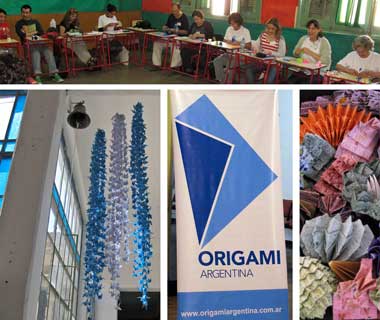To celebrate the beginning of World Origami Days on this date, October 24th, I post twenty four memories and highlights from the First Origami Convention held in Rosario, Argentina and of my first visit ever to Buenos Aires and Rosario.
- Laura Azcoaga,
 a great expert on modular origami, met me at Ezeiza International Airport on the early morning of October 6th, and introduced me with map in hand to the Buenos Aires. Laura’s studio is a delightful place full of models and papers enough to get lost in for hours of contemplation.
a great expert on modular origami, met me at Ezeiza International Airport on the early morning of October 6th, and introduced me with map in hand to the Buenos Aires. Laura’s studio is a delightful place full of models and papers enough to get lost in for hours of contemplation. - Noelia Avila
 was a generous and attentive host to me and other international visitors.She was as well a wonderful tour guide and ambassador for the great city of Buenos Aires. Noelia set me up with Jaciara Grzybowski and Tatiana Renón for a second day walking tour around central Buenos Aires.
was a generous and attentive host to me and other international visitors.She was as well a wonderful tour guide and ambassador for the great city of Buenos Aires. Noelia set me up with Jaciara Grzybowski and Tatiana Renón for a second day walking tour around central Buenos Aires. - At Centro Cultural Borges –a 19th century historic building located in Galerías Pacífico in Buenos Aires is where I attended a show with Jaciara and Tatiana honoring Sadako Sasaki and the International Day of Peace. The aim of the show was the folding of a thousand cranes by public visitors that would be sent to the Peace Memorial Park in Hiroshima, Japan at show’s end. At the center I taught Maria Teresa del Campo how to fold a crane.
- Trip to Rosario: I shared a car traveling from Buenos Aires to Rosario through the eastern Wet Pampas under clear blue skies with Laura Azcoaga, Maria Eugenia Sandín, and Maricel Centi. At one of the rest and refreshment stops along the way, I bought two big bags of juicy ripe oranges.
- The convention in Rosario was cozy and full of a creative spirit and delicious camaraderie. It opened on Friday night, October 8th, at the Culture and Education Ministry of Rosario, the same location where a large origami exhibition open to the public was being held.
- Meri Affranchino,
 president of Origami Argentina, was a fabulous convention host and event organizer. Meri radiated enthusiasm and together with an excellent team of volunteers produced a wonderful event that displayed her significant organizational and diplomatic skills. Every aspect of the convention was very well prepared, and flawlessly coordinated.
president of Origami Argentina, was a fabulous convention host and event organizer. Meri radiated enthusiasm and together with an excellent team of volunteers produced a wonderful event that displayed her significant organizational and diplomatic skills. Every aspect of the convention was very well prepared, and flawlessly coordinated. - Silvia Serra,
 educator and writer, made the official introduction of the first issue of Plegando al Sur, a new magazine published by Origami Argentina. In addition to publishing diagrams for various models, Plegando al Sur contains interesting articles on the history of origami in Argentina, and origami used as an educational tool.
educator and writer, made the official introduction of the first issue of Plegando al Sur, a new magazine published by Origami Argentina. In addition to publishing diagrams for various models, Plegando al Sur contains interesting articles on the history of origami in Argentina, and origami used as an educational tool. - Polo Madueño,
 a life-long origami practitioner, and a good link between the old and the new origami in Argentina, told a beautiful story of how his grandfather and father introduced him to origami, which he practiced for a long time all by himself, sharing his adventures and explorations almost exclusively with his father. Thanks to the Internet, Polo found people from around the world with whom to share ideas related to paper folding, greatly expanding his community.
a life-long origami practitioner, and a good link between the old and the new origami in Argentina, told a beautiful story of how his grandfather and father introduced him to origami, which he practiced for a long time all by himself, sharing his adventures and explorations almost exclusively with his father. Thanks to the Internet, Polo found people from around the world with whom to share ideas related to paper folding, greatly expanding his community. - Classes and the exhibition were held at Elementary School Number 56 Almafuerte, in Rosario. Each room was lavishly decorated with modular models hanging from the ceiling.
- Jaciara Grzybowski
 was the special guest from Brazil, Jaciara’s specialty is the creation of delicate modular mandalas that showcase repeating patterns and also the play of light and the transparency of the paper. At the convention, Jaciara launched her new book Papeis Mandalas e Flocos de Neve where she demonstrates how to make the mandalas. Jaciara also taught a method that imparts a translucent quality to any paper, as well as several models including: a ring with a crane, a wallet, and a bat that flaps when it’s launched into the air.
was the special guest from Brazil, Jaciara’s specialty is the creation of delicate modular mandalas that showcase repeating patterns and also the play of light and the transparency of the paper. At the convention, Jaciara launched her new book Papeis Mandalas e Flocos de Neve where she demonstrates how to make the mandalas. Jaciara also taught a method that imparts a translucent quality to any paper, as well as several models including: a ring with a crane, a wallet, and a bat that flaps when it’s launched into the air. - Miguel Kaiser,
 a gifted creator of representational models, was the special guest from Chile. He taught various models of his own creation including: an armadillo, and a modular called Meliwitran Rayen, considered a special symbol of the Mapuche culture in Chile. Miguel also demonstrated how to prepare a special paper by gluing several pieces of tissue together.
a gifted creator of representational models, was the special guest from Chile. He taught various models of his own creation including: an armadillo, and a modular called Meliwitran Rayen, considered a special symbol of the Mapuche culture in Chile. Miguel also demonstrated how to prepare a special paper by gluing several pieces of tissue together. - The exhibition of models at the convention included the work of Argentinian paper folders as well as the work from other Latin American paper folders. I would like to mention especially the tesselations of Gerardo Richarte and the intricate representational models of Oscar Simone. Particularly close to my heart was the work of Patricio Kunz from Chile. Patricio illustrated with his models different passages of the Little Prince by Antoine Sain-Exupéry, a favorite author and a very special book for me.
- Adriana Bianchi
 was the person who traveled farthest from the south to the convention; the town of Río Grande, Province of Tierra del Fuego (south of the Magellan Straits, about 1500 miles south of Rosario.) I journeyed farthest from the north, the town of Arlington, Vermont, in the northeastern United States; about 5000 miles north of Rosario.
was the person who traveled farthest from the south to the convention; the town of Río Grande, Province of Tierra del Fuego (south of the Magellan Straits, about 1500 miles south of Rosario.) I journeyed farthest from the north, the town of Arlington, Vermont, in the northeastern United States; about 5000 miles north of Rosario. - A collection of cranes in a hallway caught my eye. I liked how the light bounced off these models of blue and white papers, the colors of the Argentinian flag, as they hung next to a window.
- Between the Folds, a video by Vanessa Gould was shown with subtitles in Spanish.
- Teaching: I had the pleasure of teaching three models to two enthusiastic groups. One model was a modular accordion box authored by Ayako Kawato. Then there was a windmill by Philip Chapman-Bell, and another windmill by Hajime Komiya. Informally I taught a spider and a fly.
- Learning: I learned a dragonfly and a modular from Miguel Kaiser; a tato fold from Tatiana Renón; a charming lion from Gregorio Vainberg; a modular ball (Hans Werner-Guth) from Walter Lambies; a bat and a ring from Jaciara Grzybowski; a modular box from Laura Azcoaga; and a bird-basket from Noelia Avila.
- Visit to La Isla de los Inventos The island of inventions in Rosario is a renovated train station, currently a cultural center, where children and adults can learn and play by working with different art materials and technologies. Every town in the planet should have places like this where children and adults can learn through hours of play and creative freedom.
- I received all sorts of gifts and goodies from various friends and I felt the excitement and lightness of a child at Christmas. I particularly loved the treasures that Gabi Orzo brought for me from her home in Patagonia.
- Snacks, lunches, and dinners, were delicious. No trip to Argentina would be complete without sampling the delectable alfajor- a snack made from a thin layer of dulce de leche sandwiched between between two cookies. And then there were the empanadas of course, a half-moon shaped pastry shell of baked dough filled with beef, cheese, chicken, or vegetables. Bakeries or ‘confiterias’ are not to be missed with their delicious media lunas (croisants) and all sort of scrumptious pastries. So yummy!
- Back to Buenos Aires after the convention, I saw an exhibition of Noelia’s origami at The Japanese Garden. I also visited The Museum of Latin American Art of Buenos Aires –MALBA, and strolled around the historic and picturesque San Telmo and Caminito neighborhoods.
- Paper Shops in Buenos Aires: No origami trip would have been complete without browsing through some paper shops. I visited The Wussman Shop (at Rodriguez Peña 1399), and Papelera Palermo. My favorite though was the studio of Laura Azcoaga where I bought some beautiful origami paper carefully chosen from a large selection. I also bought Laura’s book “Todo sobre el Sonobe” (All about the Sonobe module).
- Tango! Gregorio Vanberg a fellow origami practitioner took Tatiana Renón and me to an informal street tango presentation by the well known Cedrón Quartet led by the legendary and beloved Argentinian guitar player and tango singer, Juan “Tata” Cedrón. We all watched and listened as Cedrón performed tangos and other popular rythms on the sidewalk outside the vegetable market Verdulería de José, in his neighborhood at the intersection of Jonte and Cuenca streets. A sizeable audience gathered to listen. Some sang along while others danced tango as the quartet played. It was a special experience to witness this performance of great Argentinian music.
 Gregorio noted that of particular interest to paper folders is the fact that the bandoneon (one of tango’s classical instruments) uses a bellows that folds and unfolds to produce its sound.
Gregorio noted that of particular interest to paper folders is the fact that the bandoneon (one of tango’s classical instruments) uses a bellows that folds and unfolds to produce its sound. - On my last day in Argentina I was able to attend a conference and workshop on Japanese wrapping at Palermo University in Buenos Aires.
Looking at the trip as a whole, I learned and experienced a great deal in a very short period of time. From the warmth with which all my paper folding friends welcomed me to their beautiful country, I felt very much at home in Argentina.





Leyla- Your pictures and descriptions evoke so many wonderful and colorful sights, sounds, and even tastes. A real treat for the senses :-) What lovely photos and memories- Thank you for sharing them!